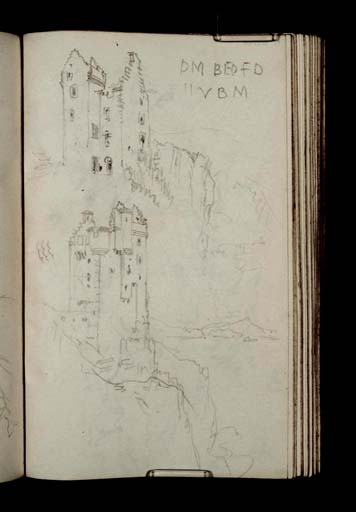J.M.W. Turner
>
1830-35 Annual tourist
>
Scotland 1831
>
Staffa Sketchbook
>
Artwork
Joseph Mallord William Turner Gylen Castle 1831
Image 1 of 2
Joseph Mallord William Turner,
Gylen Castle
1831
Joseph Mallord William Turner 1775–1851
Folio 73 Verso:
Gylen Castle 1831
D26885
Turner Bequest CCLXXIII 73a
Turner Bequest CCLXXIII 73a
Pencil on white wove paper, 186 x 116 mm
Inscribed in pencil by Turner ‘DM BEOFD | II VBM’ top right
Inscribed in pencil by Turner ‘DM BEOFD | II VBM’ top right
Accepted by the nation as part of the Turner Bequest 1856
References
1909
A.J. Finberg, A Complete Inventory of the Drawings of the Turner Bequest, London 1909, vol.II, p.878, CCLXXIII 73a, as ‘Ruined castle on rock. –“DM BEOFD IIVBM.”’.
1991
David Wallace-Hadrill and Janet Carolan, ‘Turner in Argyll in 1831: Inveraray to Oban’, Turner Studies, vol. 11, no.1, Summer 1991, pp.27, 29.
Judging by the number of sketches devoted to it (25 pages), Gylen Castle at the south of the island was Turner’s main object of interest in his visit to Kerrera. While the castle was not considered as a subject to illustrate Sir Walter Scott’s Poetical Works, and had little connection with the poet, Turner seems to have been interested in the founders of the castle, Clan MacDougal, evinced by inscriptions on the present page and 77 verso (D26893). His main interest, however, as Wallace-Hadrill and Carolan suggest, was probably in the picturesque and imaginative potential of the castle,1 which the Steamboat Companion describes as ‘a small, beautiful and picturesque ruin, perched on the extreme verge of an almost perpendicular precipice’.2
Crossing over from Gallanach near Oban, Turner landed at the east of the island and either walked across to Barnabuck at the west before approaching the castle, or approached the castle directly from the north, before making his way to Barnabuck. While Wallace-Hadrill and Carolan favour the first route,3 the fact that the Staffa sketchbook was generally used by Turner from the back to the front suggests that the latter route is more likely. In this case, Turner began sketching on folio 75 verso with a few views of the castle and the Sound of Kerrera from the north (folios 73 verso–75 verso; D26885–D26889), before examining the castle from the east (folios 68–73; D26874–D26884) and then sketching as he walked west away from the castle (folios 63 verso–67 verso; D26865–D26873; CCLXXIII 63a–67a) towards Barnabuck (folios 61–63; D26860–D26864).
The present page was used for two close-up studies of the castle: at the top is a study from the south, and beneath is a view from the north. Behind the castle to the right in the lower sketch are the Sound of Kerrera and the coast of Argyll near Clachan. To the left of the sketch Turner drew the corbels that support the window in the north-east wall. By drawing the opposite corners of the castle, Turner could record its south-east and south-west, and its north-east and north-west facades in just two sketches. Recording a wealth of architectural detail in two close-up sketches allowed Turner to draw a simplified or generalised version of the castle in his other sketches which concentrated instead on topography. It is interesting to note that the Steamboat Companion described the castle as ‘overgrown with thick mantling ivy, reaching from the bottom of the rock to the very battlements of the fortress’.4 There is no sign of this thick covering of ivy in any of Turner’s sketches of the castle. There was therefore either no ivy when he saw it, or he deliberately omitted it in order to record the architecture more clearly.
To the right of the top sketch Turner inscribed ‘DM BEOFD | II VBM’. This lettering has been identified by David Wallace-Hadrill and Janet Carolan as belonging to an inscribed stone panel on the castle which in fact read: ‘DMDFOFD | VBM’ and stood for ‘Duncan MacDougal Friar of Dunollie’ and ‘Virgo Beata Maria’.5 The panel was said to be covered in moss by 1887, but was presumably legible when Turner visited.6 The fragment is now at Dunollie House.7
Thomas Ardill
February 2010
James Lumsden and Son, Lumsden and Son’s Steamboat Companion and Stranger’s Guide to the Western Isles and Highlands of Scotland, Edinburgh 1831, quoted in Wallace-Hadrill and Carolan 1991, p.27.
James Lumsden and Son, Lumsden and Son’s Steamboat Companion; or Stranger’s Guide to the Western Isles and Highlands of Scotland, Glasgow 1839, p.140.
‘Gylen Castle, Kerrera’, Royal Commission on the Ancient and Historical Monuments of Scotland, http://www.rcahms.gov.uk/ accessed 22 February 2010.
How to cite
Thomas Ardill, ‘Gylen Castle 1831 by Joseph Mallord William Turner’, catalogue entry, February 2010, in David Blayney Brown (ed.), J.M.W. Turner: Sketchbooks, Drawings and Watercolours, Tate Research Publication, December 2012, https://www


